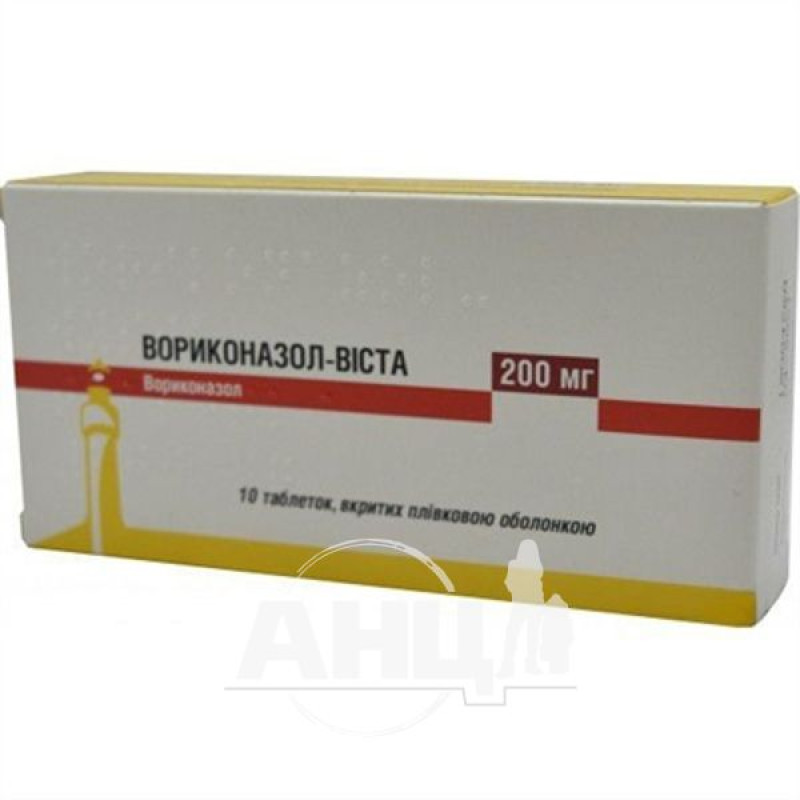Voriconazole-Vista film-coated tablets 200 mg blister No. 10

Voriconazole-Vista tablets are used for the indications listed below.
Prevention of invasive fungal infections in allogeneic bone marrow transplantation in patients at high risk of such a complication.
Voriconazole is used in adults and children to treat:
Invasive aspergillosis; Candidaemia without neutropenia; Severe invasive infections caused by Candida (including C. krusei) resistant to fluconazole; Severe fungal infections caused by Scedosporium and Fusarium species.Voriconazole should be used as initial therapy in patients with progressive and potentially life-threatening infections.
Composition
Active ingredient: voriconazole (one film-coated tablet contains 200 mg of voriconazole).
Excipients: lactose monohydrate; povidone K 29-32; croscarmellose sodium; pregelatinized starch; magnesium stearate; purified water.
Coating components: lactose monohydrate; hypromellose; titanium dioxide (E 171); triacetin; purified water.
Contraindication
Hypersensitivity to the active substance or to any of the excipients. Concomitant use with CYP3A4 substrates, terfenadine, astemizole, cisapride, pimozide or quinidine, as increased plasma concentrations of these medicinal products may lead to prolongation of the QTc interval and, rarely, torsades de pointes. Concomitant use with rifampicin, carbamazepine and phenobarbital, as these medicinal products may significantly reduce voriconazole plasma concentrations. Concomitant use of standard doses of voriconazole with efavirenz at a dose of 400 mg per day or higher, as efavirenz at such doses significantly reduces voriconazole plasma concentrations in healthy volunteers. Voriconazole also significantly increases efavirenz plasma concentrations. Concomitant use with high doses of ritonavir (400 mg or higher twice daily), as the use of such doses of ritonavir leads to a significant decrease in the concentration of voriconazole in the blood plasma in healthy volunteers. Concomitant use with ergot alkaloids (ergotamine, dihydroergotamine), which are substrates of CYP3A4, as increased plasma concentrations of these drugs may lead to ergotism. Concomitant use with sirolimus, as voriconazole may significantly increase the concentration of sirolimus in the blood plasma. Concomitant use with St. John's wort preparations.Method of application
Voriconazole-Vista should be taken at least 1 hour before or 1 hour after a meal. Before starting the drug and during its use, monitoring of electrolyte imbalances, such as hypokalemia, hypomagnesemia, hypocalcemia, and, if necessary, their correction is necessary.
Application features
Pregnant women
Voriconazole should not be used during pregnancy unless the benefit to the mother outweighs the potential risk to the fetus.
Women of reproductive age should always use effective contraception during treatment.
The excretion of voriconazole in human milk has not been studied. Breastfeeding should be discontinued when initiating treatment with voriconazole.
Animal studies have not shown any impairment of fertility.
Children
The safety and efficacy of voriconazole in children under 2 years of age have not been established. Voriconazole is prescribed to children aged 2 years and older. Elevations of liver enzymes have been observed more frequently in children. Liver function should be monitored in children and adults. Oral bioavailability may be limited in children aged 2 to 12 years with malabsorption and very low body weight for their age. In such cases, administration of voriconazole is recommended.
The incidence of phototoxic reactions is higher in children. Since squamous cell carcinoma (SCC) has been reported, strict sun protection measures are warranted in this patient population. Children with photoaging of the skin, such as lentigines or ephelides, are advised to avoid sun exposure and to seek dermatological evaluation even after discontinuation of treatment.
Drivers
Voriconazole has a moderate influence on the ability to drive and use machines. It may cause temporary and reversible visual changes, including blurred vision, altered/increased visual perception, and/or photophobia. If these symptoms occur, patients should avoid potentially hazardous activities such as driving or operating machinery.
Overdose
There are three reports of accidental overdose. All cases occurred in children who received intravenous doses of voriconazole up to five times the recommended dose. A single adverse reaction of photophobia lasting 10 minutes has been reported.
There is no known antidote to voriconazole.
Voriconazole is hemodialyzable with a clearance of 121 mL/minute. In case of overdose, hemodialysis may help remove voriconazole from the body.
Side effects
The most commonly reported adverse reactions were visual disturbances, pyrexia, rash, vomiting, nausea, diarrhea, headache, peripheral edema, abnormal liver function tests, respiratory distress syndrome, and abdominal pain.
Store in the original packaging at a temperature not exceeding 25 °C, out of the reach of children.
Shelf life - 3 years.
There are no reviews for this product.
There are no reviews for this product, be the first to leave your review.
No questions about this product, be the first and ask your question.







